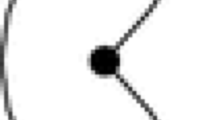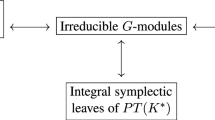Abstract
Let \(\textrm{G}\) be a split, simple, simply connected, algebraic group over \({\mathbb {Q}}\). The degree 4, weight 2 motivic cohomology group of the classifying space \(\textrm{BG}\) of \(\textrm{G}\) is identified with \({\mathbb {Z}}\). We construct cocycles representing the generator, known as the second universal motivic Chern class. If \(\textrm{G}= \mathrm{SL(m)}\), there is a canonical cocycle, defined by Goncharov (Explicit construction of characteristic classes. Advances in Soviet mathematics, 16, vol 1. Special volume dedicated to I.M.Gelfand’s 80th birthday, pp 169–210, 1993). For any group G, we define a collection of cocycles parametrised by cluster coordinate systems on the space of \(\textrm{G}\)-orbits on the cube of the principal affine space \(\textrm{G}/\textrm{U}\). Cocycles for different clusters are related by explicit coboundaries, constructed using cluster transformations relating the clusters. The cocycle has three components. The construction of the last one is canonical and elementary; it does not use clusters, and provides the motivic generator of \(\textrm{H}^3(\textrm{G}({\mathbb {C}}), {\mathbb {Z}}(2))\). However to lift it to the whole cocycle we need cluster coordinates: construction of the first two components uses crucially the cluster structure of the moduli spaces \(\mathcal{A}(\textrm{G},{{\mathbb {S}}})\) related to the moduli space of \(\textrm{G}\)-local systems on \({{\mathbb {S}}}\). In retrospect, it partially explains why cluster coordinates on the space \(\mathcal{A}(\textrm{G},{{\mathbb {S}}})\) should exist. The construction has numerous applications, including explicit constructions of the universal extension of the group \(\textrm{G}\) by \(K_2\), the line bundle on \(\textrm{Bun}(\textrm{G})\) generating its Picard group, Kac–Moody groups, etc. Another application is an explicit combinatorial construction of the second motivic Chern class of a \(\textrm{G}\)-bundle. It is a motivic analog of the work of Gabrielov et al. (1974), for any \(\textrm{G}\). We show that the cluster construction of the measurable group 3-cocycle for the group \(\textrm{G}({\mathbb {C}})\), provided by our motivic cocycle, gives rise to the quantum deformation of its exponent.






Similar content being viewed by others
References
Beilinson, A.A.: Higher regulators and special values of L-functions (1984)
Bloch, S.: Higher Regulators, Algebraic K-Theory, and Zeta Functions of Elliptic Curves. Irvine Lecture Notes. CRM Monograph series, AMS 2000. Original preprint of (1977)
Bloch, S.: Applications of the dilogarithm function in algebraic K-theory and algebraic geometry. In: Proceedings of the International Symposium on Algebraic Geometry, Kinokuniya, Tokyo (1978)
Brylinsky, J.L., Deligne, P.: Central extensions of reductive groups by \({ K}_2\). Publ. Math IHES 94, 5–85 (2001)
Deligne, P.: Le symbole modéré. Publ. Math. IHES 73, 147–181 (1991)
Dimofte, T., Gabella, M., Goncharov, A.B.: K-Decompositions and 3d Gauge Theories. arXiv:1301.0192
Faddeev, L.D., Kashaev, R.: Quantum dilogarithm. Mod. Phys. Lett. A 9, 427 (1994). arXiv:9310070
Fock, V.V., Goncharov, A.B.: Moduli spaces of local systems and higher Teichmuller theory. Publ. Math. IHES 103, 1–212 (2006). arXiv:AG/0311149
Fock, V.V., Goncharov, A.B.: Cluster ensembles, quantization and the dilogarithm. Ann. Sci. École Norm. Sup. 42, 865–929 (2009). arXiv:AG/0311245
Fock, V.V., Goncharov, A.B.: Cluster \({\cal{X}}\)-varieties, amalgamation, and Poisson–Lie groups. Algebraic Geom. Number Theory (2006). arXiv:math/0508408
Fomin, S., Zelevinsky, A.: Cluster algebras. I. J. Am. Math. Soc. 15(2), 497–529 (2002)
Gabrielov, A., Gelfand, I.M., Losik M.: Combinatorial computation of characteristic classes I, II. Funct. Anal. I Ego Pril. 9, 12–28 (1975). ibid 9, 5–26 (1975)
Goncharov, A.B.: Polylogarithms and motivic Galois groups. In: Proceedings of Symposia in Pure Mathematics, Motives. Seattle, WA, 55, pp. 43–96 (1991)
Goncharov, A.B.: Explicit construction of characteristic classes. In: Advances in Soviet Mathematics, 16, v. 1, Special Volume Dedicated to I.M. Gelfand’s 80th Birthday, pp. 169–210 (1993)
Goncharov, A.B.: Exponential complexes, period morphisms, and characteristic classes. Ann. Fac. Sci. Toulouse, vol. XXV, no. 2–3, pp. 397–459 (2016). arXiv:1510:07270
Goncharov, A.B., Shen, L.: Donaldson-Thomas trasnsformations of moduli spaces of G-local systems. Adv. Math. 327, 225–348. arXiv:1602.06479
Goncharov, A.B., Shen, L.: Quantum geometry of moduli spaces of local systems and Representation Theory. arXiv:1904.10491, version 2
Keller, B.: Cluster algebras and derived categories. In: Derived Categories in Algebraic Geometry, pp. 123–183, EMS Ser. Congr. Rep., Eur. Math. Soc., Zürich (2012). arXiv:1202.4161
Keller, B.: Quiver mutation and combinatorial DT-invariants. Contribution to the FPSAC (2013). http://webusers.imj-prg.fr/bernhard.keller/publ/index.html
Laszlo, Y., Sorger, Ch.: The line bundles on the moduli of parabolic \({\rm G}-\)bundles over curves and their sections. Ann. Sci. l’ENS. 4e série Tome 30(4), 499–525 (1997)
Lee, R., Szczarba, R.: The group \(K_3({\mathbb{Z} })\) is a cyclic group of order \(48\). Ann. Math. 104, 31–60 (1976)
Suslin, A.A.: The group \(K_3\) of a field and the Bloch group. Proc. Steklov Inst. Math. 183, 217–239 (1991)
Acknowledgements
This work was supported by the NSF grants DMS-1900743, DMS-2153059. The first author is grateful to Linhui Shen for useful discussions. We are very grateful to the referee, who carefully red the text, and made a lot of useful comments and suggestions which improved the exposition.
Author information
Authors and Affiliations
Corresponding author
Additional information
Publisher's Note
Springer Nature remains neutral with regard to jurisdictional claims in published maps and institutional affiliations.
Rights and permissions
Springer Nature or its licensor (e.g. a society or other partner) holds exclusive rights to this article under a publishing agreement with the author(s) or other rightsholder(s); author self-archiving of the accepted manuscript version of this article is solely governed by the terms of such publishing agreement and applicable law.
About this article
Cite this article
Goncharov, A.B., Kislinskyi, O. Cluster construction of the second motivic Chern class. Sel. Math. New Ser. 29, 57 (2023). https://doi.org/10.1007/s00029-023-00854-x
Accepted:
Published:
DOI: https://doi.org/10.1007/s00029-023-00854-x




